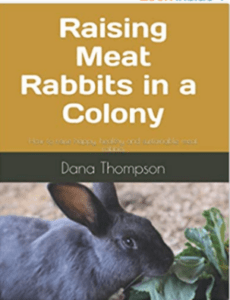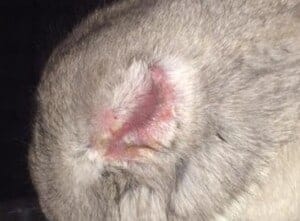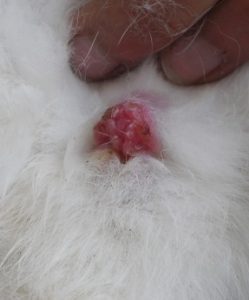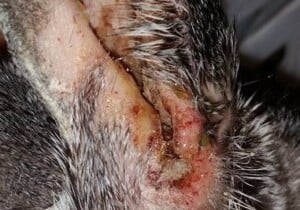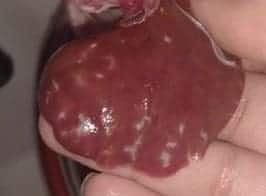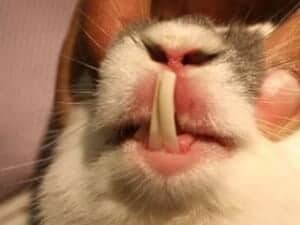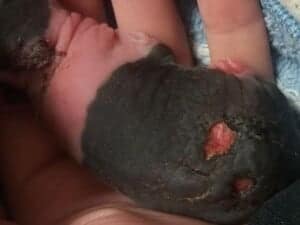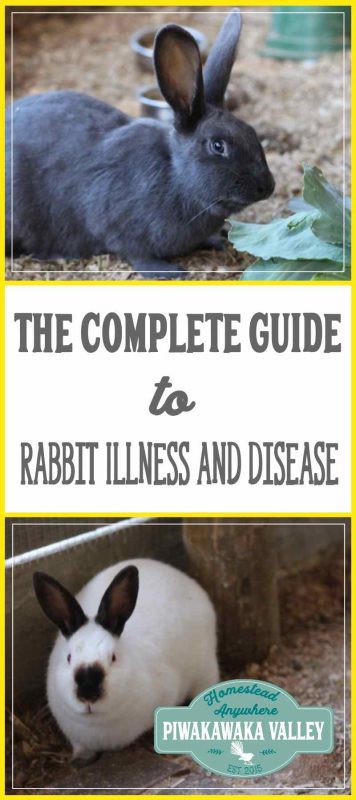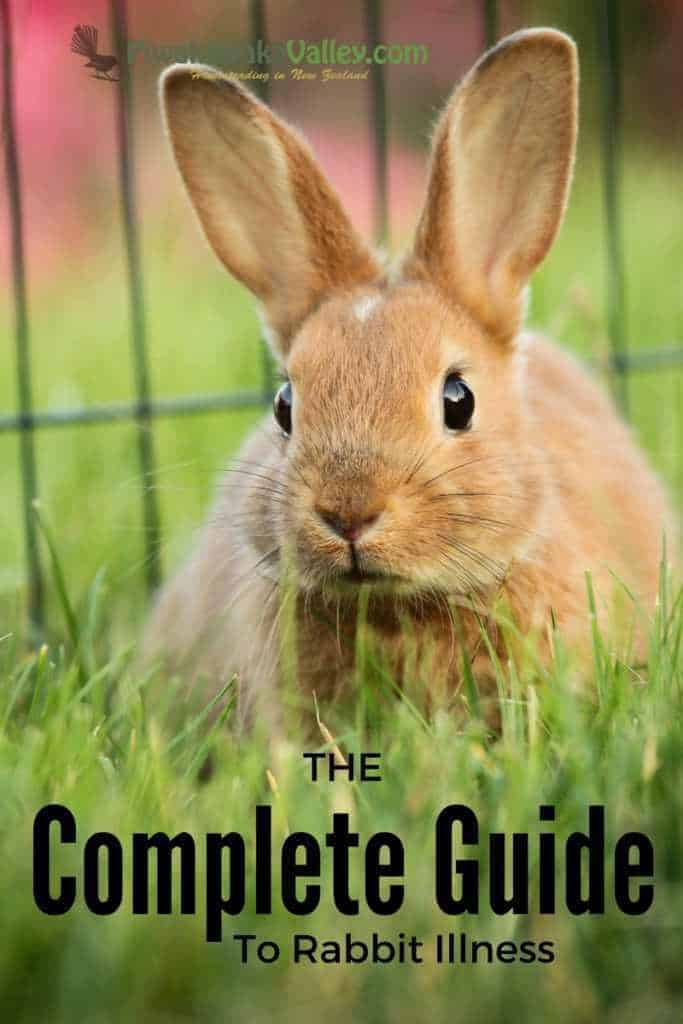This post was most recently updated on July 27th, 2021
Rabbits are fragile creatures. It is quite common for a pet rabbit to suddenly die out of the blue, and they can easily get sick with common rabbit illnesses. If you have a sick rabbit with a runny nose or is off their food, this rabbit illness guide will help you diagnose what is wrong with your bunny.
Please read: This information is provided for educational purposes only and is not intended to treat, diagnose or prevent any disease. We encourage you to make your own health care decisions in partnership with a qualified health care professional.
This post contains affiliate links, this means at no extra cost to you, we make a commission from sales. Please read our Disclosure Statement
Before you look at treating an illness, you should read about preventing the spread of illness in your rabbitry and how to keep your rabbits healthy.
Rabbit Diseases Reference Guide
WARNING: This diary discusses housing, rabbit diseases and raising of rabbits for human consumption and contains graphic pictures. If this topic disturbs you, please do not proceed. I am not a vet, as always with sick animals check with your friendly vet before treating.
Bacterial:
Pasteurellosis / Pasturella – including snuffles and pneumonia
Enteritis – including weaning sickness
Listeriosis
Necrobacillosis
Salmonellosis
Staphlococcosis
Conjunctivitis – Nest eye
Viral:
Vent disease – Rabbit syphilis
Hutch burn
Tularemia
Myxomatosis
Rabbit pox
Fibroma
Warts
Viral Hemorrhagic Disease, Rabbit Calicivirus
Parasites:
Ear mites
Fur mites, Fleas and Ticks
Bot flies
Coccidiosis
Toxoplasmosis
Roundworms
Tapeworms
Nutritional:
Pregnancy Toxemia / Eclampsia
Vitamin A deficiency
Vitamin E deficiency
Glaucoma
Genetic:
Eating:
Constipation
Not eating
Cannibalism
Other:
Over heating
Broken back
Sore hocks
Hairballs
Yellow fat
Broken bones
UTI and Bladder infections
Want to know all about raising rabbits in a colony?
Check out our very own book here:
Available on Kindle and in paperback or from our store
Bacterial Illness
Pasteurellosis
Pasteurellosis is the umbrella name given to the rabbit diseases caused by Pasteurella multocida. Conditions include the following: rhinitis (snuffles), pneumonia, pyometra, orchitis, otitis media, conjunctivitis, subcutaneous abscesses, and septicemia.
Rhinitis (Snuffles)
This is when the mucous membranes of the nasal sinuses become infected by bacteria.
Symptoms: Include sneezing, snuffly sounds and a mucous discharge from the nose. They will often have crusty dried mucous on their front paws from wiping their nose.
Causes: Pasteurella bacteria often are found naturally in the nasal sinuses of healthy‑looking rabbits. Stress resulting from extremes of temperature, high humidity, high ammonia levels, travel, pregnancy, and lactation is a primary factor in the development of snuffles.
Treatment: A trip to the vet might get you some antibiotics, but this probably isn’t what you want if it is a meat rabbit anyway. The only effective method of control within the rabbitry is strict culling. If a rabbit has a nasal discharge or matted paws or sneezes on 2 consecutive days, cull it from the herd. If you are not sure whether to cull a rabbit, “when in doubt, cull it out.” Otherwise the next time it is stressed it will simply relapse and share the germs around with other rabbits.
Herbal Options: Cough/respiratory issues: Coltsfoot, dandelion, Elderflower, licorice, Marjoram, Plantain, Rosemary – add a handfull of leaves to their feed twice per day. And add 2 cloves of Garlic to their drinking water.
Pneumonia
Snuffles if left to continue will develop into pneumonia.
Symptoms: Depression, labored breathing, bluish eye color in albinos, fever and a nasal discharge. On necropsy the lungs will have large lesions of the lungs which appear as red consolidated areas, sunken purple areas, and pus filled abscesses.
Treatment: Pneumonia rarely is treated in rabbitries as it usually is a postmortem diagnosis. Broadspectrum antibiotics may be used with some degree of success with pet and show rabbits if you wish to try.
Herbal Options: Cough/respiratory issues: Coltsfoot, dandelion, Elderflower, licorice, Marjoram, Plantain, Rosemary – add a handfull of leaves to their feed twice per day. And add 2 cloves of Garlic to their drinking water.
Pyometra
Pyometra is the fancy term for pus in the uterus. Affected females can not have kits and, therefore, are culled and often slaughtered. Often the only symptom is a lack of kindling/pregnancy and diagnosis usually only occurs at slaughter.
Orchitis
Orchitis is an infection of the testicles.
Symptoms: The testicle becomes enlarged and usually contains an abscess. Pus can be seen when the testicle is cut open. Sometimes infection is limited to the membranes covering the penis, a condition called balanoposthitis.
Treatment: Treatment seldom is attempted as the buck will probably be sterile at the end of the process, and will be a carrier for Pasteurellosis as well.
Otitis Media / Ear Infection
Middle ear infection of one or both ears causes filling of the tympanic cavity with pus. If the infection spreads to the inner ear, it affects the rabbits balance, and head tilt or wryneck results. Treatment is fairly ineffective.
Herbal Options: Anti-inflammatory: Chickweed, Birch leaves and bark, Willow leaves and bark, Golden Rod, licorice, Marjoram, Plantain – add some to their food twice per day.
Prevent/fight infections: Echinacea, Garlic (can put it in the water), Nasturtium, Plantain – add some to their food twice per day.
Subcutaneous Abscesses
Pasteurella may cause abscesses in several organs, but abscesses are particularly obvious when they occur in the subcutaneous tissue.
Symptoms: These appear as soft swellings under the skin.
Treatment: Consists of opening and draining the abscess and administration of systemic antibiotics.
Herbal Options: Anti-inflammatory: Chickweed, Birch leaves and bark, Willow leaves and bark, Golden Rod, licorice, Marjoram, Plantain – add some to their food twice per day.
Prevent/fight infections: Echinacea, Garlic (can put it in the water), Nasturtium, Plantain – add some to their food twice per day.
Septicemia
This form of pasteurellosis usually is an overwhelming infection in the blood of short duration without clinical signs, resulting in death.
Enteritis
“Enteritis” is a group of rabbit diseases much like “pasteurellosis.” Any diarrheal‑type disease that kills rabbits is referred to as enteritis. If you see diarrhea in your rabbits as a precaution you should remove all food except for hay/straw and water for a few days and see if it clears by itself, this is quite common during the weaning stage as they are growing their gut bacteria colonies.
In general if you see a rabbit with loose stools:
Soft stools: Remove all food except hay and water and feed blackberry/raspberry/strawberry leaves and some of the following: Lemon Balm, Licorice, Mint, Plantain, Thyme.
Watery stools: As above but add a small handful of leaves and stems of Shepherd’s Purse twice a day for three or four days.
Enterotoxemia / Weaning Sickness
Symptoms: Explosive diarrhea, a disease affecting rabbits 4–8 weeks of age. Rabbits often are observed to be normal one day and dead the next.
This acute death is due to a deadly toxin produced by the bacteria Clostridium spiroforme which normally resides in the rabbit’s gut, but is allowed to bloom/overgrow due to an imbalance of diet – too much sugar/carbohydrates and not enough fibre will often set it off. Penicillin used to treat rabbits for other conditions may also cause the disease by altering the gut bacteria.
Treatment: Penicillin may help, but usually the affected rabbit will die. The typical lesions of enterotoxemia seen at necropsy are a fluid‑filled intestine that is covered with petechial hemorrhages.
Prevention: The type of diet seems to be a factor in the development of the disease. Diets high in fiber reduce the incidence of the disease. The addition of hay or straw to a low‑fiber diet is beneficial. This is one of the rabbit diseases that hand reared kits will often end up with.
Gastrointestinal Dilation / Gastrointestinal Obstruction / Bloat
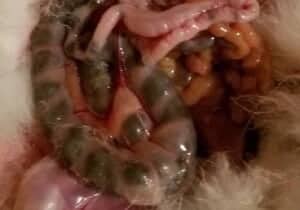
Bloat is one of the most common rabbit diseases causing death in many domestic rabbits. Bloat is caused by a sudden and complete obstruction (or blockage) of the intestines and is characterised by a stomach/git full of gas.
Usually the blockage occurs in the small intestine, just 2-3 inches past the stomach. The stomach fills with gas and fluid and becomes very dilated, like an over-inflated balloon putting pressure on the heart and lungs. It is extremely painful and will end in death.
Symptoms: Rabbits stop eating and moving, they will sulk in a corner and may grind their teeth and squeal when touched. They will look more rounded than usual.
Treatment: Do not massage the rabbit’s stomach, as this can make the situation worse. Seek immediate veterinary care or put the rabbit out of its misery. Prevention is much easier – A diet high in fiber and low in sugar & plenty of exercise, are paramount. Avoid too much gas causing foods at once eg. cabbage, broccoli, cauliflower, kale.
Herbal Options: Bloating/gas: Lemon Balm, Mint, Parsley Root. A very old fashioned preventative measure, is a few dried coarse bramble/blackberry leaves, fed with hay.
Mucoid Enteropathy
Symptoms: This uncommon enteric disease affects rabbits of any age and is a chronic type of diarrhea or constipation. Rabbits live for several days and sometimes several weeks with this disease. Not eating, sitting hunched in the cage, grinding their teeth as if in pain. They sometimes look bloated and often are crouched near the water supply.
Treatment: By the time the disease is recognized, the rabbit seldom can be saved. Re-hydration with electrolytes sometimes is beneficial. The addition of excess salt to the feed occasionally helps stop an outbreak. On autopsy most show an enlarged impacted bowel with mucous deposits.
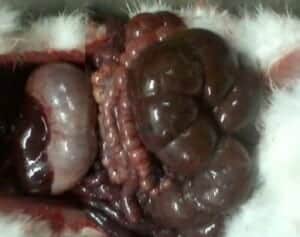
Herbal Options: Comfrey, Bromelian (papaya/pawpaw, pineapple), Slippery Elm Bark all help stimulate the gut.
Tyzzer’s Disease
Symptoms: In weanling animals are diarrhea, listlessness, lack of appetite, and dehydration, followed by death within 72 hours. Lesions include edema, hemorrhage, and necrosis in the wall of the cecum and focal necrosis in the liver and heart.
Treatment: There is no effective treatment in rabbits. Prevent it by strict sanitation, especially daily thorough removal of fecal material from the cage floor. Because this seems to be a highly transmissible disease, the only way to treat severe outbreaks is to depopulate and repopulate with disease‑free rabbits.
Listeriosis
Listeria monocytogenes causes a rare septicemic infection in young rabbits, a meningoencephalitis in adults, and metritis and fetal mortality in pregnant does.
Symptoms: Depressed, weak, has a nasal discharge, and may have convulsions. Nervous system signs include incoordination, loss of balance, and rolling movements.
Treatment: Antibiotics of the tetracycline group are the best drugs for treating listeriosis but will only work if caught early.
Necrobacillosis
Symptoms: Lesions first appear on the lower lip, which becomes swollen, purplish, and painful to the touch. Later, small abscesses are seen that contain a thick, purulent pus. This leads on to ulcers and necrotic breakdown of the skin and subcutaneous tissues in the face, head, and neck. When the liver and lungs become involved, the animal becomes emaciated and dies.
Treatment: When the disease is recognized and treated with antibiotics in its early stages, recovery is usual.
Herbal Options: May or may not help – Prevent/fight infections: Echinacea, garlic (can put it in the water), Nasturtium, Plantain, Colloidal Silver.
Salmonellosis
Salmonella organisms are spread easily by fecal contamination, and a single infected animal can quickly infect a whole colony.
Symptoms: The first signs are listlessness, ruffled hair coat, loss of appetite, and diarrhea. Later, the breathing rate increases, and body temperature may rise. Septicemia and rapid death follow quickly, with diarrhea and abortion commonly observed.
When outbreaks occur, they often are explosive, with high morbidity and mortality. Mortality is highest in young rabbits and pregnant does.
Treatment: When caught quickly, antibiotics are effective.
Herbal Options: Prevent/fight infections: Echinacea, Garlic (can put it in the water), Nasturtium, Plantain, Colloidal Silver.
Staphylococcosis
Staphylococcus aureus causes septicemic infections and abscesses in numerous organs.
Symptoms: Abscesses including the subcutaneous tissue, lungs, kidneys, and heart. This organism is known especially for causing infection in the mammary glands of nursing does. The breasts become swollen, hot, and may become bluish, hence the alternate name “blue‑breast.”
The doe may refuse to nurse her young and generally loses her appetite. Young from does with mastitis should not be fostered to other nursing does because the disease might be transmitted to the foster doe.
Treatment: Antibiotics may well be helpful, but several strains of Staph are now resistant to some antibiotics so they may need to get lab test done to see what ones will work for you.
Herbal Options: Try treating local skin infections with honey or Colloidal Silver.
Conjunctivitis (Weepy Eye)
Symptoms: Red, swollen eyes with a copious exudate, eyelids can be stuck shut.
Treatment: Opening the eyelids, if stuck shut, cleaning the eye with saline, and applying an eye ointment containing an antibiotic.
Herbal Options: Make a herbal Eye Wash: Make a strong Chamomile tea brew and add a spoonful of honey. Allow to cool and use to wash eye 2-3 times a day.
Treponematosis (Vent Disease/Rabbit Syphilis)
Symptoms: Lesions of treponematosis may resemble those of injury, fungal infection, or ectoparasites. A correct diagnosis is important because the disease is transmitted primarily by breeding, and an isolated case can lead to an outbreak among the breeding stock.
The first signs usually are small blisters around the external sex organs. Lesions involving the nose, mouth, and ears also occur in both sexes. The lesions are irregular in shape, tan‑brown, and either edematous or dry and scaly.
Treatment: Penicillin is effective, however, may cause fatal enterotoxemia in some rabbits.
Herbal Options: Could be worth trying Colloidal Silver with some immune boosters like Echinacea, garlic (can put it in the water), Nasturtium, Plantain
Hutch Burn
Symptoms: Often confused with rabbit syphilis. Hutch burn affects the membranes of the anus and genital region. They become very red and chapped. The major cause is wet and dirty cage floors that come in contact with these membranes.
Treatment: A gentle wash in warm water with a tablespoon of baking soda, then a thorough dry. Clean dry bedding is a must, with daily or twice a day changes. An antibiotic cream will ensure a secondary infection doesn’t set in and will provide a barrier to aide healing.
Tularemia / Rabbit Fever/ Deerfly Fever
Symptoms: Infected rabbits move sluggishly and are visibly sick. Yellow or white spots on the liver or spleen are common lesions. Diagnosis is made by bacterial cultures of suspect lesions.
Treatment: Usually disease is diagnosed on necrotomy. Sanitation measures stop it spreading.
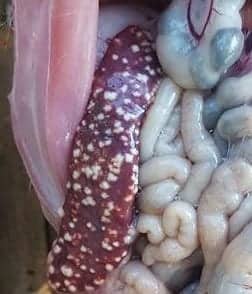
Viral diseases
In general there are no real treatments for viral diseases. The trick is to keep your rabbits healthy with regular doses of immune boosting plants like Echinacea, garlic (can put it in the water), Nasturtium and Plantain.
If your rabbits does get sick you can give them the following to help keep them comfortable while they fight the infection:
Pain relief: Birch leaves and bark, Willow leaves and bark, Chamomile
Reduce Fever: Plantain
Calming: Chamomile, Comfrey, Lavender flowers (small amounts only), Lemon Balm, Rosemary
Myxomatosis
Symptoms: Eyes with a purulent/pusy discharge and fever. Swelling of the ears causes them to become heavy and floppy. As the disease progresses, swelling of the rest of the head and genital region and a nasal discharge occur; death follows in 10–12 days.
In survivors, widespread gelatinous tumors under the skin develop all over the body, including the eyelids. Rarely, acute outbreaks of myxomatosis occur and rabbits die in 1-2 days.
About the only signs observed are a slight redness in the conjunctival membranes and fever. On necrotomy there is congestion and consolidation of the lungs, and the spleen is enlarged, dark red, and pulpy.
Treatment: There is no treatment. Prevention includes removing mosquitos or screening in your rabbitry and avoiding contact with wild rabbits. Control of an outbreak consists of prompt identification of the disease, destruction of infected animals by burning their bodies.

Rabbit Pox
Symptoms: The lesions include lymphadenitis (lymph node swellings in neck, under front legs etc), papular nodules (looks like acne) on the mucous membranes, and orchitis. Mortality is highest among the unweaned young and may reach 75 percent.
Treatment: No treatment, but there is a vaccine.
Fibroma
Symptoms: Can vary from small, hard subcutaneous nodules to diffuse hard areas involving muscles and tendons. The external genitalia become red and swollen. It can also affect the kidneys, liver, intestinal tract, bone marrow, and mesentery. Death is frequent in unweaned young.
Treatment: There is no treatment. Prevention includes removing mosquitos or screening in your rabbitry and avoiding contact with wild rabbits. Control of an outbreak consists of prompt identification of the disease, destruction of infected animals by burning their bodies.
Rabbit Papilloma (Warts)
The most common sites for papillomas are the ears and eyelids, and the growths vary in size and conformity. As the warts become older, they increase in size, become more cornified, and are hard to the touch. The upper surfaces are irregular and often split. The lower portions of the growth are pinkish and fleshy to the touch. They are harmless and will usually self-resolve.
Viral Hemorrhagic Disease / Rabbit Haemorrhagic Disease / Rabbit Calicivirus Disease
Read here for more information about avoiding RCD/VHD in your rabbitry.
Symptoms: Uncoordination, convulsions, and evidence of severe pain. There usually is a bloody nasal discharge. Mortality rate of affected animals is very high. Postmortem examination reveals hemorrhages throughout the body organs such as the lungs, liver, heart, spleen, and mucous membranes.
The liver is extremely swollen and brownish red. VHD causes rapid development of blood clot formation in major organs such as the heart, lungs and kidneys.
The clots block blood vessels causing heart and respiratory failure. An infected rabbit that has died from VHD will often have its legs straight out and head over its neck.
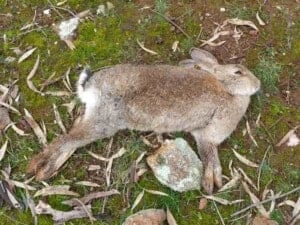
Treatment: There is no treatment, prevention or vaccination are the two options. Clothing, contaminated food, cages, bedding, feeders and water can harbour the virus. Urine, faeces and respiratory secretions shed the virus. The virus may also be carried by the wind and flies.
Rabbit fleas and mosquitoes can also spread the virus between rabbits, carriers of the virus may remain infectious for up to 3 months.
If you have a confirmed case of VHD you must self quarantine for minimum 3 months, do not sell or show any rabbits in that time, do not go to a vet with a rabbit or visit anyone else that has rabbits.
All hay you plan on giving your rabbits must be stored for minimum 3 months to ensure any wild VHD is no longer active and if you have wild VHD in your area avoid feeding your rabbits grass that may be contaminated unless your rabbits are vaccinated.
Fungal Diseases
Symptoms: Fungus infections cause patchy areas of hair loss and thickened skin covered with yellow, dry crusts. The hairs may be broken close to the skin surface and become matted. The name “ringworm” is suggested by the circular lesion that often develops from the outward growth of the fungi. Patches usually are found on the nose, ears, eyelids, and feet.
Treatment: In single cases a topical anti-fungal cream will work well. For more wide-spread disease an oral antifungal can be used in their feed or water. Fungal infections usually occur in warm moist environments, so try and keep areas well ventilated and dry.
Herbal options: Tea Tree, Rosemary and Lavender essential oils and Honey are all anti-fungals, as is Colloidal Silver. You can apply these topically every day for 2-3 weeks. I would suggest mixing 3T honey with 3-5 drops of essential oil and 3-5 drops colloidal silver (optional) and using as a salve on the fungal infective area.
Parasitic diseases
Ear mites
Symptoms: Causes ear mange or canker. This condition very common. The mites live in the ear canal and damage the skin lining this area. An exudate of brown, waxy material soon covers the inner ear.
Treatment: Requires perseverance, if ear mites are detected in one rabbit, they likely are in others in the herd also. To eradicate the mites you need to treat all rabbits in the herd regardless of whether ear mites are detected.
Treating just the one rabbit will result in continually treating one or two rabbits a week. Most mineral‑oil‑based ear mite medications containing a parasiticide are effective, as are treatments using ivermectin. Some people swear by simply using mineral oil alone as it suffocates the mites.
Treat for the first 2 days than every other day for 14 days after this, 2 times a week for the next 2 weeks ear mites have a 28 day life cycle so you must treat up to the 28 days to make sure all the mites are killed.
Fur Mites, Fleas and Ticks
Symptoms: In healthy, well‑fed rabbits these seldom cause a problem and rarely are noticed. If a rabbit becomes sick or is underfed, baldness, sores, or scabs may develop in the neck or back. Intense itching may occur, which causes constant scratching and the consequent loss of hair and injury to the skin.
Treatment: You can use cat flee powder or treat with ivermectin.
Herbal Options: Eucalyptus and Sage – dried and powdered sprinkle around bedding. Guinea fowl eat ticks and live in peace with rabbits. Diatomaceous earth in a dust bath in the colony will allow the rabbits to roll in the dust, killing fleas, mites and ticks. You can also put a good layer of diatomaceous earth on the floor to kill the parasites.
Cuterebrid flies/Bot Flies
Rabbits are infected when the fly deposits eggs on the fur. Grubs hatch from these eggs and burrow into the skin to form warbles. The larvae grow under the skin and may get as long as three‑quarters of an inch. When full-grown, the grubs leave the skin and develop into adult flies.
Treatment: While they are gross, they seldom cause any problems to the host. You can remove them by widening the hole and pulling them out with tweezers.
Internal parasites
Coccidiosis
A prevalent parasitic disease of domestic rabbits. It is caused by a microscopic parasite that invades the intestine or liver. The parasite multiplies extensively and then sheds eggs in the feces. At least four types of coccidia live in the intestine, and one species grows in the liver.
Symptoms: Healthy rabbits tolerate moderate numbers of cocci without displaying illness. Diarrhea, poor appetite, weight loss, and sometimes death.
Treatment: Control of intestinal coccidiosis depends largely on management practices that minimize the danger of fecal contamination of feed, water, and floors. Corrid can be added to water to treat the whole group of rabbits.
It takes 3 days for eggs to become infectious. After ingesting an infectious egg, 8 new parasites “hatch,” and those 8 turn into hundreds or thousands more that send eggs out in the poop just 18 days later.
Mix the 20% powder at 2 tsp per gallon of water. Keep that in front of them constantly (make it fresh every 24 hours) for at least 14 full days. Every other day, the colony needs to be as completely cleaned of poop as possible.
Scrub feeders, waterers, hides, and anything else you can with a 10% ammonia solution and let it dry (don’t rinse).
After 14 days of Corid water as mixed above, give the rabbits a 7 day break and offer fresh, unmediated water. That is 21 total days (the time it takes for eggs pooped out today to become reproducing coccidia). Then, repeat the Corid water mixed at ONE teaspoon per gallon of water, for 14 more days.
You MUST remove as many coccidia eggs as possible, every 2 days for the ENTIRE 35 day period.
You can use barn lime on the floors (it dries up moisture which can help keep the eggs you miss from becoming infectious)
Toxoplasmosis
Symptoms: In the acute form, the rabbit stops eating, fever, lethargy, and (in a few days) central nervous symptoms ranging from the inability to move to generalized convulsions. Death usually occurs about a week. With the chronic form, either no symptoms are observed or there is a progressive weight loss that might end in posterior paralysis and death.
At necropsy, the lesions vary. In the acute form, there is extensive necrosis of the lymph nodes, liver, spleen, and lungs.
Treatment: In most cases is not practical, and the emphasis should be on prevention. Cats, the primary carrier of this disease, should be kept out of rabbitries or at least away from feed storage areas. Keep food and water poop free.
Roundworms
Symptoms: These pinworms are white, and 1⁄2 inch long. They often are seen on the surface of freshly passed feces or through the wall of the large bowel when rabbits are slaughtered.
Treatment: With de-worming medication.
Herbal Options: Garlic oil, Grapefruit seed extract (10 drops in a gallon of water for 2 weeks.), lamb’s quarters.
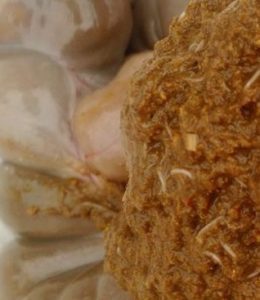
Tapeworms
Tapeworms occur in rabbits as adults in the intestine and as larva in the liver and abdominal cavity.
Symptoms: Tapeworms are flat, ribbon‑shaped, and made up of numerous segments. It has a head with four suckers to attach to the lining of the intestine.
Rabbits harboring a few tapeworms show no signs of the disease. When many tapeworms are present, diarrhea and weight loss might occur.
Treatment: Is not practical, so control must be accomplished by management. Keep dogs away from the rabbits and keep food and water free from poop.
Nutritional diseases
Pregnancy Toxemia / Eclampsia
Symptoms: Most common in first litter females. Signs are: Dullness of the eyes, sluggishness, respiratory distress, prostration, seizures and death after 1 to 4 days from onset. The usually disease occurs in the last week of pregnancy and is much more prevalent in obese animals.
Treatment: Birth of the litter or abortion will cure her if either occurs shortly after the onset of signs, if toxemia is too far progressed by the birth the mother will die anyway. Junior does should not be too fat when bred for the first litter.
Herbal Options: To bring on labour or re-start stalled labour or expel retained placenta : Blue cohosh – only give when you are sure rabbit is over due, will cause abortion if not overdue/due. Start with 2 small leaves every 3-4 hours and see how she progresses. Lavender – Use with caution and sparingly.
To help prevent Toxemia try:
PREGNANCY TONIC- Combine the following dried, raspberry leaf, nettle, and goats rue (Galega officinale) in equal parts, and half part Milk Thistle (Silybum marianum). Feed: 1 Tbs. per day at feeding time, to pregnant Does beginning one week before kindling through the first month. These herbs help ease kindling, offer nutrition and support lactation.
Vitamin A Deficiency
Symptoms: Low fertility, abortions, resorption, and hydrocephalus in kits born to low Vitamin A mothers.
Treatment: Vitamin A rich foods like alfalfa. WARNING a diet too high in synthetic vitamin A has the same symptoms!
Vitamin E Deficiency
Infant mortality, characterized by death of entire litters at 3 to 10 days of age without clinical signs prior to death.
Treatment: Can be remedied by increasing vitamin E foods like alfalfa.
Hereditary Diseases
Glaucoma
Symptoms: Appears first as a light bluish cloudiness on the cornea. One or both eyes may be affected. Progressive opacity follows, and protrusion of the eyeball becomes noticeable. Eventual blindness occurs.
Recommendation: Cull from breeding stock.
Malocclusion
Symptoms: Gradual loss of appetite and weight. Both sides of the mouth may become stained with saliva. Animals become progressively listless, dehydrated, and unable to chew properly. Complications are abscessed teeth, growth of teeth into the upper jaw, and death from starvation.
Recommendation: Incisors can be trimmed back so the animals can eat and attain good condition before slaughter – do not use for breeding.
Splay Leg and Ataxia
Symptoms: Splay leg – an inability to put weight on one or both hind legs, the limbs are twisted so the animals have a double-jointed posture. Affected animals are not paralyzed, they eat normally, seem to be well, and move by wriggling along on their belly and chest. The pathologic effects are limited to the hip and shoulder.
Ataxia – a lethal recessive genetic disorder. It usually appears when the animal is 2 to 3 months of age and runs its course in a month. In ataxia, the nervous system is involved, and at first the animal might not be able to use its hind legs effectively. Later the animal cannot move, and its body temperature drops below normal and they die.
Recommendation: Cull from breeding stock. If the parental combination continues to pass these issues on I suggest you cull one or both of the parents.
Other Health Issues
Constipation
If you think your rabbit is suffering from constipation try add these foods to their daily diet, also ensure they are getting enough fibre and plenty of fresh water.
Laxative: Borage, Cleavers, dandelion, linseed/flaxseed, Parsley Root
Not Eating
Rabbits can go off of their food for many reasons, but if you need to stimulate their appetite try some of the following:
Stimulate appetite: Blackberry leaves, comfrey, Mint, Rosemary.
Cannibalism
Most cases of cannibalism are the result of a diet that is inadequate in either quality or quantity, injury or abnormality in a baby rabbit, or disturbance of the doe following kindling.
A proper diet and a safe place to hide at kindling usually prevent the tendency. A valuable doe that destroys her first litter should be given another chance. If she continues to kill young, she should be culled from the breeding population. Breeding does at 4-4 1/2 months greatly reduces first time mothers anxiety.
Heat prostration / Over Heating
Provide relief to adult animals suffering from the heat by spraying them with water or placing a wet burlap feed sack on the cage floor for them to rest on. A frozen bottle of water placed in the cage for the rabbits to lie up against is helpful.
Remove some bedding and fur from nest boxes to improve circulation of air around kits. Fans can help keep air circulating. Allowing the rabbits to burrow is an excellent way of ensuring they keep themselves and their kits cool.
Herbal Options: Anything that increases circulation will aide the rabbit in cooling down – Blackberry, Dandelion, Sorrel, Strawberry.
Broken Back
Sudden paralysis with no apparent cause. Paralysis extends down from the middle of the back and may be complete or partial (paresis). The animal moves with its front legs and drags the hindquarters. If a rabbit is completely paralyzed, it generally is killed to prevent suffering, as the bladder loses the ability to empty and can explode.
However, some success has been observed in does with paresis (some motor function or sensory capability) by putting the rabbit in a small cage for 30 to 60 days. Some anti inflammatories and steroids may also help the healing. The smaller cage limits the rabbit’s activity and allows time for healing.
Herbal Options: Try adding some anti-inflammatory foods: Birch or willow leaves and bark, Chickweed, Golden Rod, Licorice, Marjoram, Plantain.
Sore Hocks
Sore hocks are inflamed hairless spots on the bottom surface of the hind legs. In severely affected cases, secondary infections can set in requiring antibiotics. Sore hocks are caused by wet, dirty hutch floors and the irritating with action of urine salts.
The breed also is a factor, as the disease is seen more often in large breeds than in smaller breeds and Rex rabbits are prone to them because of thin foot pads.
Prevention: First, cull all affected breeders from the breeding herd because of their thin foot pads. Second, if they are caged rabbits keep a clean, dry resting pad in the cage for them to rest on. Check the cage daily for rough or rusty spots. Rabbits kept on deep litter or dirt seldom have this ailment.
Fur Eating and Hairballs
The cause generally is a lack of dietary fiber. Diets high in cereal grains and low in alfalfa and hay often have a low fiber content. This causes the animal to seek another source of fiber, and hair chewing begins. Increasing fiber in the diet almost always stops the problem.
If a hairball is suspected, a gentle massage of the (delicate) stomach and administration of 10 ml of pineapple juice by stomach tube or medicine dropper 3 days in a row might help.
An enzyme in the juice can help break up the hairball and allow it to pass through the digestive system. Surgery or slaughter might be needed in some cases.
Other foods that stimulate the gut to keep moving include: Comfrey, Bromelian (papaya/pawpaw, pineapple core), Slippery Elm Bark.
Yellow Fat
While technically not a disease, it is often seen and worried about or confused with jaundice. Yellow body fat is merely an inherited condition in rabbits. It is the inability to convert xanthophyll found in many green foods to a colourless byproduct. Therefore, the xanthophyll is deposited in the body fat, making it yellow. It is perfectly safe to consume.
Broken bones
Comfrey helps speed bone healing, and add some anti-inflammatories to the daily diet as well – Chickweed, Birch leaves and bark, Willow leaves and bark, Golden Rod, licorice, Marjoram, Plantain.
Immobilise/splint the bone and keep the rabbit in a very small cage to minimise movement.
Bladder Infections/ Bladder Sludge
Bladder infections: dandelion, Echinacea, Parsley, Dandelion root tea in the water with cranberry treats several time a week will help with any problems. As usual a daily dose of Colloidal Silver and or Garlic Oil will help treat any infections.
A diuretic will ensure they are urinating plenty to clear the sludge caused by a diet too high in calcium. Diuretics include Birch and Plantain.
Please Pin and Share with your friends!


